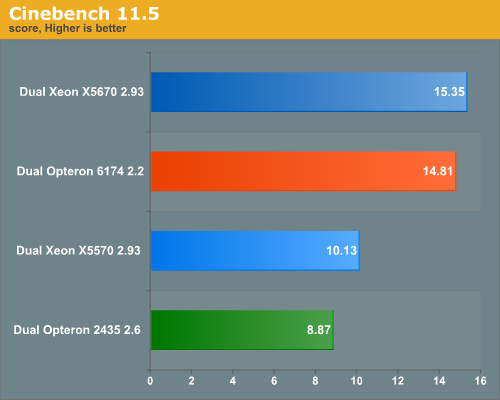AMD's 12-core "Magny-Cours" Opteron 6174 vs. Intel's 6-core Xeon
by Johan De Gelas on March 29, 2010 12:00 AM EST- Posted in
- IT Computing
Rendering: Cinebench 11.5
The old Cinebench 10 benchmark was limited to 16 threads. Luckily, the new Cinebench 11.5 does not have that limitation. Cinebench only represents a very small part of the 3D Animation market, but the advantage is that this a benchmark that you can perform at home too.

Although the Opteron 6174 manages to stay close to the newest Xeon, the Xeon is the CPU to get. The reason is that the performance difference will grow as you are rendering smaller and less complex scenes. In those cases, the percentage of the serial code will increase. And Amdahl’s law is unrelenting: in that case the CPU with the highest single threaded performance will win. You also get the benefit of higher single threaded performance when you are modeling.










58 Comments
View All Comments
Accord99 - Monday, March 29, 2010 - link
The X5670 is 6-core.JackPack - Tuesday, March 30, 2010 - link
LOL. Based on price?Sorry, but you do realize that the majority of these 6-core SKUs will be sold to customers where the CPU represents a small fraction of the system cost?
We're talking $40,000 to $60,000 for a chassis and four fully loaded blades. A couple hundred dollars difference for the processor means nothing. What's important is the performance and the RAS features.
JohanAnandtech - Tuesday, March 30, 2010 - link
Good post. Indeed, many enthusiast don't fully understand how it works in the IT world. Some parts of the market are very price sensitive and will look at a few hundreds of dollars more (like HPC, rendering, webhosting), as the price per server is low. A large part of the market won't care at all. If you are paying $30K for a software license, you are not going to notice a few hundred dollars on the CPUs.Sahrin - Tuesday, March 30, 2010 - link
If that's true, then why did you benchmark the slower parts at all? If it only matters in HPC, then why test it in database? Why would the IDM's spend time and money binning CPU's?Responding with "Product differentiation and IDM/OEM price spreads" simply means that it *does* matter from a price perspetive.
rbbot - Saturday, July 10, 2010 - link
Because those of us with applications running on older machines need comparisons against older systems in order to determine whether it is worth migrating existing applications to a new platform. Personally, I'd like to see more comparisons to even older kit in the 2-3 year range that more people will be upgrading from.Calin - Monday, March 29, 2010 - link
Some programs were licensed by physical processor chips, others were licensed by logical cores. Is this still correct, and if so, could you explain in based on the software used for benchmarking?AmdInside - Monday, March 29, 2010 - link
Can we get any Photoshop benchmarks?JohanAnandtech - Monday, March 29, 2010 - link
I have to check, but I doubt that besides a very exotic operation anything is going to scale beyond 4-8 cores. These CPUs are not made for Photoshop IMHO.AssBall - Tuesday, March 30, 2010 - link
Not sure why you would be running photoshop on a high end server.Nockeln - Tuesday, March 30, 2010 - link
I would recommend trying to apply some advanced filters on a 200+ GB file.Especially with the new higher megapixel cameras I could easilly see how some proffesionals would fork up the cash if this reduces the time they have to spend in front of the screen waiting on things to process.